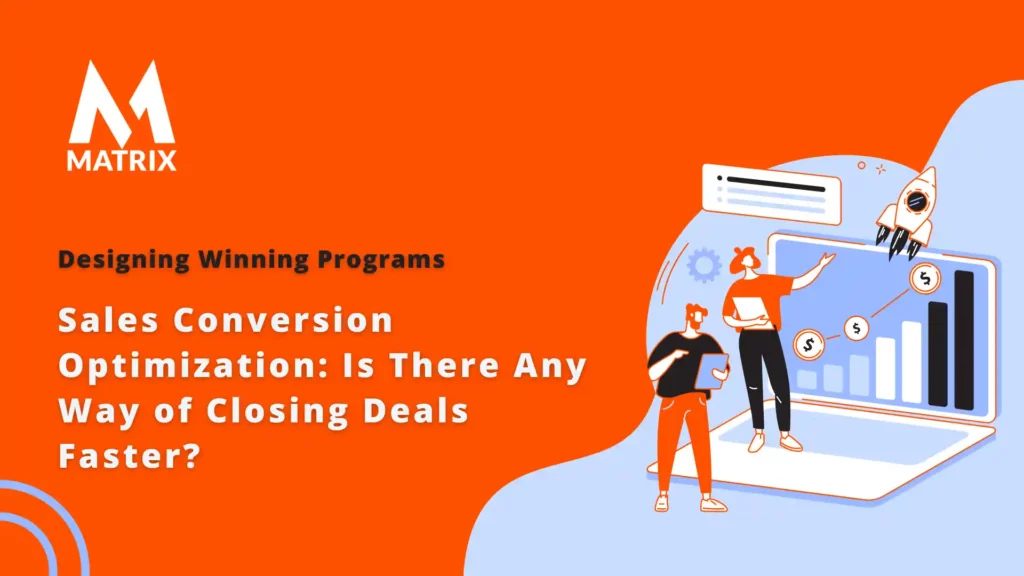You will win more business quickly if you improve your sales conversion optimization.
Sales conversion optimization: This post is part of a series to help B2B organizations improve sales and marketing cooperation. Throughout 3 posts, I’ll explain conversion rate optimization strategies and how you can win in a down economy.
A slow economy is difficult for business, and no salesperson welcomes it. This is especially true when the economy is never predicted, as with 9/11 and COVID-19. Ultimately, it boils down to diligence, marketing savvy, business ethics, and innovation.
Certainly! Here are three recent statistics related to Sales Conversion Optimization:
- Average Website Conversion Rates: The average conversion rate across all industries is approximately 2.35%. However, the top 25% of websites achieve conversion rates of 5.31% or higher. (MatrixLabX)
- Impact of Page Load Time: A delay of just one second in page load time can lead to a 7% reduction in conversions.
- Effectiveness of Personalized Calls-to-Action (CTAs): Personalized CTAs perform 202% better than basic, non-personalized ones
These statistics highlight the importance of optimizing website performance and personalizing user interactions to enhance sales conversions.
With the Big Tech layoff, businesses are scrambling to optimize the use of the cloud SaaS models. New business models are needed to be successful.
My ecommerce friends should be doing an ecommerce conversion audit at least once a year, if not daily real-time reports. I love dashboards that tell me the speed we’re going and if the engine is firing on all cylinders.
In part one, you’ll get the basics of beginning the process and the information and agreements you must implement to ensure success in a slow or down economy.
Things like, were you on solid footing before? Is your foundation strong, or is it crumbling? A slow economy exposes a lot of issues. Content Translation Services: A Competitive Advantage for Your Business
Google Ads Checklist – Download Now! 🚀
Struggling to get the most out of your Google Ads? 🔥 Download our Google Ads Optimization Checklist and take your campaigns to the next level!
✅ Maximize Clicks & Conversions
✅ Lower Your Cost-Per-Click (CPC)
✅ Improve Ad Quality Scores
✅ Target the Right Audience
This free checklist will help you set up, optimize, and scale your Google Ads campaigns for maximum ROI.
As the water in the pipeline stream lowers, more and more foundational and structural issues get exposed.
“Because of the state of euphoria over what (software vendors) thought they could deliver, there was a time over the past two or three years where they over-promised and dramatically under-delivered. And they didn’t have a great tendency to listen.”
– Steve David, CIO at Procter & Gamble
“So, if you want to sell to me, come into my office with a demonstrated solution to a problem I’ve got. … That means you’ve got to understand my business, how I make my money, and my problems.”
– Roger Krone, VP & GM of Boeing Rotorcraft
Faced with this kind of corporate reaction, high-tech vendors are frustrated with the stiff barriers erected by corporations in making IT investment decisions. This applies to most small businesses and those in a down economy.
Many software company executives and sales reps – especially those who grew up professionally during past years – find it extraordinarily tough to adapt to the challenges of today’s marketplace.
The situation is worse than one might have imagined just a few months ago.
“The worst software buying environment in memory” is one complaint I regularly hear. So, what more can one do to develop and close deals except try harder and harder against all odds?
Denver Digital Marketing Agencies are Failing Their Clients.
I would go so far as to argue that two key qualities in today’s sales force and management rank count for more than any others: firstly, contrarian, inquisitive thinking, and secondly (believe it or not) solid sales discipline.
I believe these qualities will be rewarded significantly more than the aggressive, even bold, marketing/sales approaches that characterized the past.
Puzzlingly, many firms still seem unable to give up their hard-sell tactics despite all the evidence that they don’t work today, even for ‘established’ product categories, such as ERP, Supply Chain, and CRM.
In this article, I shall share with you an approach that, after over 30 years in enterprise and small business sales (including a start at IBM), I know will work, provided you apply it consistently.
The approach I describe can ensure success for any company with decent (i.e., not necessarily exceptional) product offerings in a relevant product or service category (i.e., not necessarily a recognized hot category).
Furthermore, I will make the following assertion: Unless your company is a bonafide leader in an established, growing product category, every time you lead with a product (as most software vendors still do), I can assure you that you are likely to fail in today’s market.
Monitoring and improving your Sales Conversion Optimization (SCO) requires a strategic mix of tools, tactics, and testing. Here’s a practical breakdown you can implement:
How to Monitor Sales Conversion Optimization
1. Track Key Conversion Metrics
Use tools like Google Analytics 4 (GA4), Hotjar, or HubSpot to measure:
- Conversion Rate: % of visitors who take a desired action.
- Bounce Rate: A high bounce could signal poor landing page messaging.
- Average Session Duration: Indicates engagement levels.
- Cart Abandonment Rate: This is especially important for e-commerce.
- Lead Quality & Close Rates: From CRM tools like Salesforce or HubSpot.
2. Use Heatmaps and Session Recordings
- Tools like Hotjar, Crazy Egg, or Microsoft Clarity let you visually track user behavior.
- See where users click, how far they scroll, and where they drop off.
3. Monitor Funnel Performance
Break down your sales funnel by stages:
- Landing page → Form fill → Sales call → Proposal → Close Track conversion at each step to find leaks.
How to Improve Sales Conversion Optimization
1. Optimize Your Landing Pages
- Clear headlines that speak to pain points.
- Strong, action-oriented CTAs (test colors, positions, and copy).
- Social proof: testimonials, reviews, trust badges.
- Mobile-first design (most traffic is mobile!).
2. Run A/B Tests
Use Google Optimize, Optimizely, or VWO to:
- Test different page layouts, CTA copy, imagery, and forms.
- Implement changes based on statistically significant results.
3. Simplify Forms
- Only ask for essential info upfront.
- Use multi-step forms if necessary to avoid overwhelming users.
4. Use Exit-Intent Popups
- Offer a discount or capture email before a user leaves.
- Tools: Sleeknote, OptinMonster, Privy.
5. Personalize User Experience
- Show dynamic content based on behavior or source (email, ad, organic).
- Tools: Dynamic Yield, HubSpot Smart Content, or Clearbit Reveal.
6. Follow Up With Abandoners
- Use email retargeting or ads to re-engage users.
- Abandoned cart emails for e-commerce.
- Retargeting ads for service-based businesses.
Bonus: Sales Enablement Tactics
- Align sales and marketing: make sure sales have access to MQL behavior.
- Use lead scoring to prioritize high-intent visitors.
- Implement chatbots or live chat to assist in real time.
Want help designing a custom SCO dashboard or testing plan for your business or a client? I can mock that up for you in seconds.
The new selling approach to win more business faster

Sales conversion optimization can help you increase your revenue while saving you money. What if you could close one more deal per month? How about 2 or 5?
As we all know, the scenario inside large corporate organizations today is quite different from what it was just three years ago, when arguably the top ten IT projects at any one time may have been funded at some point.
This was probably due partially to the wasteful nature of corporate IT investment management at the time—profligacy that has now come home to roost, as billions of dollars of unimplemented software and equipment lie on the shelf in these organizations.
This goes for legacy and SaaS software vendors. In contrast, the situation in most corporations today is that, in relative terms, only the top three IT projects on the list at any given time stand a chance of getting funded.
Every sales rep’s job is to ensure that the deal they are trying to close is part of one of those few funded projects. How to Choose the Right AI Digital Marketing Agency: A Comprehensive Guide for Marketing Managers
Put another way, the obstacle course that most technology vendors face today can look as daunting as this:
- First, you have to ‘compete’ against all other proposed IT projects to be one of the customer’s ‘top three’ funded investments (knowing that even these can be deferred at any time);
- Then, you have to compete against existing in-house initiatives and workarounds;
- If you are still standing at this point, you must then compete against the threat of the customer using some of the excess ‘shelf’ software acquired during the past two or three years;
- Then, you confront the threat of vendors from an adjacent product category who may claim to solve the same set of problems as your category addresses;
- Finally, you may be competing against vendors in your category! (it wasn’t supposed to be this difficult, but this is the nature of the game nowadays.)
Looking further, how corporate budgets are being managed can send misleading signals to understandably antsy sales reps.
Affordable SEO Solutions That Drive Real Results
Matrix Marketing Group Delivers Customized SEO Strategies with Transparent Pricing for Maximum ROI. See SEO Services.
. What are Digital Marketing Services?
And that it will generate a payoff in the short term, the chief executive is asking one simple but critical question that is enough to put a nail in the coffin of many a promising investment proposal: “Why now?”
Just as software vendors in the early 2000s became versed in skills like finding where the budgets are in their customers’ organizations, the puck has now moved to a different spot on the ice: let’s face it, enterprise customers have become used to fending off vendors’ advances with the ‘vanishing budget’ argument.
And when customers apologize late in the sales cycle that their budget has been ‘frozen’, it may be no exaggeration these days.
Despite what some sales professionals might want to believe, corporate budgets are nothing more than best-guess funding allocations made in a prior fiscal year or quarter and liable to be temporarily or permanently ‘frozen’ or ‘reallocated’ at any time that economic conditions warrant greater caution or resource scarcity.
Drive Better Results with a Complimentary Marketing Audit
Take the guesswork out of your marketing strategy. Our Free Marketing Audit is designed to analyze your current efforts, identify gaps, and uncover growth opportunities. Whether you’re struggling with low ROI, limited engagement, or unclear targeting, we’ll provide actionable insights to help you achieve your business goals.
IT investment for sales conversion optimization
Regarding the financial justification for IT investments, I believe that customers resist vendors’ “ROI” arguments for several reasons – apart from the fact that they often come across as no more than sales enablers designed to serve the vendor’s interests:
- The ROI study does not focus on a specific, sufficiently critical problem that the customer admits to being desperate to solve to prevent an unacceptable outcome, such as lost market share, lost profits, or worse
- Vendor-driven ROI calculations often only consider the cost of licensing and implementing the vendor’s software rather than considering the investment required to solve the problem.
- It fails to show clearly what assured short-term, incremental gains will result in a first phase that will fund the remainder of the project in a second, then a third phase.
- The study does not necessarily make a case for doing it now rather than later—after all, companies manage to live with many problems, even serious ones, on an ongoing basis.
- It usually fails to establish enough in the customer’s mind why they should buy from this vendor ‘X’ versus vendors ‘Y’ or ‘Z’
Above all, I cannot over-emphasize how critical item (3) above, regarding short-term gains, can be in today’s market. Every enterprise customer knows implementing any project worth its salt will take time.
Nonetheless, the initial payoff needs to occur early in the life of any significant IT project. Many vendors, it seems, have misunderstood this to indicate that large corporations have become unreasonably concerned with achieving all the gains immediately (i.e., in two-quarters or less). This is just not the case. Digital Marketing for Solar Dealers to Increase Sales
In fact, in any significant investment, customers are quite amenable to the idea that benefits will accrue in stages over time, with some occurring in the mid-term and even the long-term – provided they can be sure of achieving some tangible benefits within a three-month or so window. Importantly, these early benefits help in a very direct way to ‘fund’ the remaining investments.
Impact on Website Performance
In 2024, 91% of organizations reported that SEO positively impacted their website performance and marketing goals. See SEO Pricing.
More than any other consideration, though, investments in relatively new categories aren’t funded out of existing budgets (because these have usually been set up to cater to investments in known product/service categories).
However, out of the only reliable funding source in tough times, in other words, the savings or new sources of revenue are unleashed by solving a critical operational problem.
So, how can companies – many of them ‘designed’ in anticipation of a ‘tornado’ of Internet-generated demand during the investment bubble – overcome such extraordinary challenges to find the necessary funding for the deals they are trying to close?
Next week, I’ll explore the second approach I recommend – “Provocation-based Selling.”
In part II, I will cover three topics related to the hand-to-hand combat required for high-tech sales teams and executives to close deals:
- (a) What do you tell the ‘top dog’ to interest them in your potential solution?;
- (b) What are the main priorities for marketing to support the field?; and
- (c) How do you take account of the differing interests of the target constituencies you must deal with in typical enterprise-level sales cycles?
Shifting from Lead Generation to Revenue Generation: A New Era for Marketing Managers
Unlocking 67% More Revenue: The Shift Every Marketing Manager Needs to Make
In today’s fast-paced digital landscape, marketing managers are bombarded with new strategies and tools claiming to revolutionize their approach. This statistic is not just a number—it’s a call to action for marketing leaders to reevaluate their strategies and realign their efforts with the bottom line. Schedule an appointment.
We’re listening to sales conversion optimization.
Have something to say about your thoughts on sales conversion optimization in a slow economy?
Please share it with us on Facebook, Twitter, or LinkedIn.
Are you not getting the results you had hoped for with your current marketing agency?
Let the experts at this professional consulting firm in Denver and Colorado help you generate more web traffic, convert leads, and close more sales.
Our team knows what it takes to build and maintain a proven marketing strategy that drives high-quality leads. For more information, check out our advertising social media marketing services or contact us to schedule a free consultation to discuss your needs and our services.
General FAQs and sales conversion optimization
What is sales conversion optimization?

In digital marketing, sales conversion optimization, or conversion rate optimization (CRO), is a system for increasing the percentage of website visitors who convert into buyers.
Why is sales conversion rate optimization important?

Conversion rate optimization (CRO) is essential because it allows you to lower your customer acquisition costs by getting more value from the visitors and customers you already have. Optimizing your conversion rate can increase revenue per visitor, acquire more customers, and grow your business quickly.
How can a recession increase sales?

It’s tough for even the best sales professionals to close deals during an economic downturn.
Seven Strategies for Selling During a Recession
1. Don’t Devalue Your Product or Service.
2. Stay Calm and Focus on Solutions. Innovate!
3. Concentrate on Fewer Leads, but Contact Them More with Harassment.
4. Don’t Neglect Your Customer Base.
5. Upgrade Your Salesforce.
6. Use SEO paired with content marketing (you should be doing this anyway)
7. Set metrics and attributions to see if you are still on the road.



